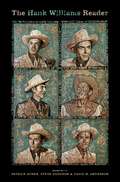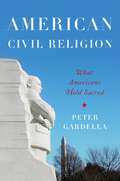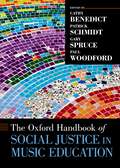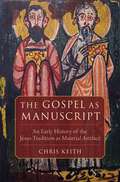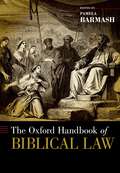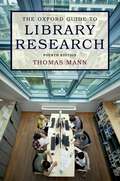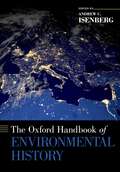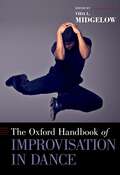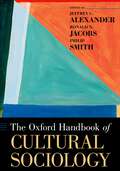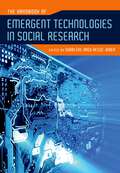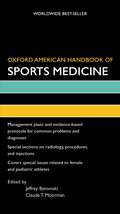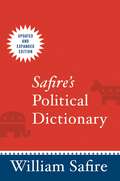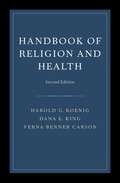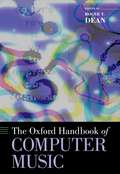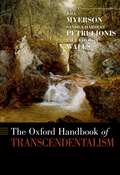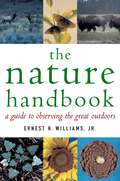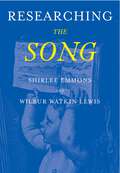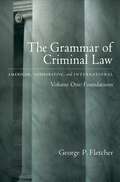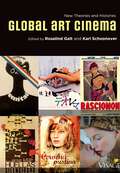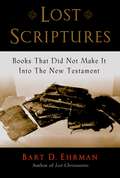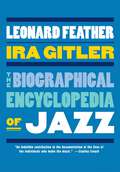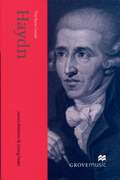- Table View
- List View
The Hank Williams Reader (Readers on American Musicians)
by Patrick Huber Steve Goodson David AndersonWhen Hank Williams died on New Year's Day 1953 at the age of twenty-nine, his passing appeared to bring an abrupt end to a saga of rags-to-riches success and anguished self-destruction. As it turned out, however, an equally gripping story was only just beginning, as Williams's meteoric rise to stardom, extraordinary musical achievements, turbulent personal life, and mysterious death all combined to make him an endlessly intriguing historical figure. For more than sixty years, an ever-lengthening parade of journalists, family and friends, musical contemporaries, biographers, historians and scholars, ordinary fans, and novelists have attempted to capture in words the man, the artist, and the legend. The Hank Williams Reader, the first book of its kind devoted to this giant of American music, collects more than sixty of the most compelling, insightful, and historically significant of these writings. Among them are many pieces that have never been reprinted or that are published here for the first time. The selections cover a broad assortment of themes and perspectives, ranging from heartfelt reminiscences by Williams's relatives and shocking tabloid exposés to thoughtful meditations by fellow artists and penetrating essays by prominent scholars and critics. Over time, writers have sought to explain Williams in a variety of ways, and in tracing these shifting interpretations, this anthology chronicles his cultural transfiguration from star-crossed hillbilly singer-songwriter to enduring American icon. The Hank Williams Reader also features a lengthy interpretive introduction and the most extensive bibliography of Williams-related writings ever published.
The Hank Williams Reader (Readers on American Musicians)
by Patrick Huber, Steve Goodson, and David M. AndersonWhen Hank Williams died on New Year's Day 1953 at the age of twenty-nine, his passing appeared to bring an abrupt end to a saga of rags-to-riches success and anguished self-destruction. As it turned out, however, an equally gripping story was only just beginning, as Williams's meteoric rise to stardom, extraordinary musical achievements, turbulent personal life, and mysterious death all combined to make him an endlessly intriguing historical figure. For more than sixty years, an ever-lengthening parade of journalists, family and friends, musical contemporaries, biographers, historians and scholars, ordinary fans, and novelists have attempted to capture in words the man, the artist, and the legend. The Hank Williams Reader, the first book of its kind devoted to this giant of American music, collects more than sixty of the most compelling, insightful, and historically significant of these writings. Among them are many pieces that have never been reprinted or that are published here for the first time. The selections cover a broad assortment of themes and perspectives, ranging from heartfelt reminiscences by Williams's relatives and shocking tabloid exposés to thoughtful meditations by fellow artists and penetrating essays by prominent scholars and critics. Over time, writers have sought to explain Williams in a variety of ways, and in tracing these shifting interpretations, this anthology chronicles his cultural transfiguration from star-crossed hillbilly singer-songwriter to enduring American icon. The Hank Williams Reader also features a lengthy interpretive introduction and the most extensive bibliography of Williams-related writings ever published.
The Oxford Handbook of Social Justice in Music Education (Oxford Handbooks)
Music education has historically had a tense relationship with social justice. One the one hand, educators concerned with music practices have long preoccupied themselves with ideas of open participation and the potentially transformative capacity that musical interaction fosters. On the other hand, they have often done so while promoting and privileging a particular set of musical practices, traditions, and forms of musical knowledge, which has in turn alienated and even excluded many children from music education opportunities. The Oxford Handbook of Social Justice in Music Education provides a comprehensive overview and scholarly analyses of the major themes and issues relating to social justice in musical and educational practice worldwide. The first section of the handbook conceptualizes social justice while framing its pursuit within broader contexts and concerns. Authors in the succeeding sections of the handbook fill out what social justice entails for music teaching and learning in the home, school, university, and wider community as they grapple with cycles of injustice that might be perpetuated by music pedagogy. The concluding section of the handbook offers specific practical examples of social justice in action through a variety of educational and social projects and pedagogical practices that will inspire and guide those wishing to confront and attempt to ameliorate musical or other inequity and injustice. Consisting of 42 chapters by authors from across the globe, the handbook will be of interest to anyone who wishes to better understand what social justice is and why its pursuit in and through music education matters.
The Gospel as Manuscript: An Early History of the Jesus Tradition as Material Artifact
by Chris Keith"But the Bible says" is a common enough refrain in many conversations about Christianity. The written verses of the four canonical Gospels are sometimes volleyed back and forth and taken as fact while the apocryphal and oral accounts of the life of Jesus are taken as mere oddities. Early thinkers inside and outside the community of Jesus-followers similarly described a contentious relationship between the oral and the written, though they often focused on the challenges of trusting the written word over the spoken-Socrates described the written word an illegitimate "bastard" compared to the spoken word of a teacher. Nevertheless, the written accounts of the Jesus tradition in the Gospels have taken a far superior position in the Christian faith to any oral tradition. In The Gospel as Manuscript, Chris Keith offers a new material history of the Jesus tradition's journey from voice to page, showing that the introduction of manuscripts played an underappreciated, but crucial, role in the reception history of the gospel. From the textualization of Mark in the first century CE until the eventual usage of liturgical readings as a marker of authoritative status in the second and third centuries, early followers of Jesus placed the gospel-as-manuscript on display by drawing attention to the written nature of their tradition. Many authors of Gospels saw themselves in competition with other evangelists, working to establish their texts as the quintessential Gospel. Reading the texts aloud in liturgical settings and further establishedthe literary tradition in material culture. Revealing a vibrant period of competitive development of the Jesus tradition, wherein the material status of the tradition frequently played as important a role as the ideas that it contained, Keith offers a thorough consideratios of the competitive textualization and public reading of the Gospels.
The Oxford Handbook of Biblical Law (Oxford Handbooks)
Major innovations have occurred in the study of biblical law in recent decades. The legal material of the Pentateuch has received new interest with detailed studies of specific biblical passages. The comparison of biblical practice to ancient Near Eastern customs has received a new impetus with the concentration on texts from actual ancient legal transactions. The Oxford Handbook of Biblical Law provides a state of the art analysis of the major questions, principles, and texts pertinent to biblical law. The thirty-three chapters, written by an international team of experts, deal with the concepts, significant texts, institutions, and procedures of biblical law; the intersection of law with religion, socio-economic circumstances, and politics; and the reinterpretation of biblical law in the emerging Jewish and Christian communities. The volume is intended to introduce non-specialists to the field as well as to stimulate new thinking among scholars working in biblical law.
OXF GUIDE TO LIBRARY RESEARCH 4E C
by Thomas MannThe information world has undergone drastic changes since the publication of the 3rd edition of The Oxford Guide to Library Research in 2005, and Thomas Mann, a veteran reference librarian at the Library of Congress, has extensively revised his text to reflect those changes. This book will answer two basic questions: First, what is the extent of the significant research resources you will you miss if you confine your research entirely, or even primarily, to sources available on the open Internet? Second, if you are trying to get a reasonably good overview of the literature on a particular topic, rather than just "something quickly" on it, what are the several alternative methods of subject searching--which are not available on the Web--that are usually much more efficient for that purpose than typing keywords into a blank search box, with the results displayed by relevance-ranking computer algorithms? This book shows researchers how to do comprehensive research on any topic. It explains the variety of search mechanisms available, so that the researcher can have the reasonable confidence that s/he has not overlooked something important. This includes not just lists of resources, but discussions of the ways to search within them: how to find the best search terms, how to combine the terms, and how to make the databases (and other sources) show relevant material even when you don't know how to specify the best search terms in advance. The book's overall structuring by nine methods of searching that are applicable in any subject area, rather than by subjects or by types of literature, is unique among guides to research. Also unique is the range and variety of concrete examples of what to do--and of what not to do. The book is not "about" the Internet: it is about the best alternatives to the Internet--the sources that are not on the open Web to begin with, that can be found only through research libraries and that are more than ever necessary for any kind of substantive scholarly research. More than any other research guide available, this book directly addresses and provides solutions to the serious problems outlined in recent studies documenting the profound lack of research skills possessed by today's "digital natives."
The Oxford Handbook of Environmental History (Oxford Handbooks)
by Andrew C. IsenbergThe field of environmental history emerged just decades ago but has established itself as one of the most innovative and important new approaches to history, one that bridges the human and natural world, the humanities and the sciences. With the current trend towards internationalizing history, environmental history is perhaps the quintessential approach to studying subjects outside the nation-state model, with pollution, global warming, and other issues affecting the earth not stopping at national borders. With 25 essays, this Handbook is global in scope and innovative in organization, looking at the field thematically through such categories as climate, disease, oceans, the body, energy, consumerism, and international relations.
The Oxford Handbook of Improvisation in Dance (Oxford Handbooks)
From the dance floor of a tango club to group therapy classes, from ballet to community theatre, improvised dance is everywhere. For some dance artists, improvisation is one of many approaches within the choreographic process. For others, it is a performance form in its own right. And while it has long been practiced, it is only within the last twenty years that dance improvisation has become a topic of critical inquiry. With The Oxford Handbook of Improvisation in Dance, dancer, teacher, and editor Vida L. Midgelow provides a cutting-edge volume on dance improvisation in all its facets. Expanding beyond conventional dance frameworks, this handbook looks at the ways that dance improvisation practices reflect our ability to adapt, communicate, and respond to our environment. Throughout the handbook, case studies from a variety of disciplines showcase the role of individual agency and collective relationships in improvisation, not just to dancers but to people of all backgrounds and abilities. In doing so, chapters celebrate all forms of improvisation, and unravel the ways that this kind of movement informs understandings of history, socio-cultural conditions, lived experience, cognition, and technologies.
The Oxford Handbook of Cultural Sociology (Oxford Handbooks)
Since sociologists returned to the study of culture in the past several decades, a pursuit all but anathema for a generation, cultural sociology has emerged as a vibrant field. Edited by three leading cultural sociologists, The Oxford Handbook of Cultural Sociology presents the full theoretical and methodological vitality of this critically significant new area.The Handbook gathers together works by authors confronting the crucial choices all cultural sociologists face today: about analytic priorities, methods, topics, epistemologies, ideologies, and even modes of writing. It is a vital collection of preeminent thinkers studying the ways in which culture, society, politics, and economy interact in the world. Organized by empirical areas of study rather than particular theories or competing intellectual strands, the Handbook addresses power, politics, and states; economics and organization; mass media; social movements; religion; aesthetics; knowledge; and health. Allowing the reader to observe tensions as well as convergences, the collection displays the value of cultural sociology not as a niche discipline but as a way to view and understand the many facets of contemporary society. The first of its kind, The Oxford Handbook of Cultural Sociology offers comprehensive and immediate access to the real developments and disagreements taking place in the field, and deftly exemplifies how cultural sociology provides a new way of seeing and modeling social facts. "This groundbreaking, readable handbook [is] the first single volume to attempt to unify its diverse contemporary applications in a wide range of traditional genres of sociology...Valuable for college universities and libraries supporting undergraduate and graduate degree programs in sociology and history."-CHOICE
The Handbook of Emergent Technologies in Social Research
Emergent technologies are pushing the boundaries of how both qualitative and quantitative researchers practice their craft, and it has become clear these changes are dramatically altering research design, from the questions researchers ask and the ways they collect data, to what they even consider data. Gathering a broad range of new developments in one place, The Handbook of Emergent Technologies in Social Research offers comprehensive, up-to-date thinking on technological innovations. In addition to addressing how to effectively apply new technologies-such as the internet, mobile technologies, geospatial technologies (GPS), and the incorporation of computer-assisted software programs (CAQDAS) to qualitative, quantitative, and mixed-methods approaches to research projects-many chapters provide in-depth examples of practices within both disciplinary and interdisciplinary environments and outside the academic world in multi-media laboratories and research institutes. Not only an authoritative view of cutting-edge technologies and their applications, the Handbook examines the costs and benefits of utilizing new technologies on the research process, the potential misuse of these techniques for methods practices, and the ethical and moral dimensions of emergent technologies, especially with regard to issues of surveillance and privacy. The Handbook of Emergent Technologies in Social Research is an essential resource for research methods courses in various fields, including the social sciences, education, communications, computer science, and health services, and an indispensable guide for social researchers looking to incorporate emerging technologies into their methods and practice.
Safire's Political Dictionary
by William SafireWhen it comes to the vagaries of language in American politics, its uses and abuses, its absurdities and ever-shifting nuances, its power to confound, obscure, and occasionally to inspire, William Safire is the language maven we most readily turn to for clarity, guidance, and penetrating, sometimes lacerating, wit. Safire's Political Dictionary is a stem-to-stern updating and expansion of the Language of Politics, which was first published in 1968 and last revised in 1993, long before such terms as Hanging Chads, 9/11 and the War on Terror became part of our everyday vocabulary. Nearly every entry in that renowned work has been revised and updated and scores of completely new entries have been added to produce an indispensable guide to the political language being used and abused in America today. Safire's definitions--discursive, historically aware, and often anecdotal--bring a savvy perspective to our colorful political lingo. Indeed, a Safire definition often reads like a mini-essay in political history, and readers will come away not only with a fuller understanding of particular words but also a richer knowledge of how politics works, and fails to work, in America. From Axis of Evil, Blame Game, Bridge to Nowhere, Triangulation, and Compassionate Conservatism to Islamofascism, Netroots, Earmark, Wingnuts and Moonbats, Slam Dunk, Doughnut Hole, and many others, this language maven explains the origin of each term, how and by whom and for what purposes it has been used or twisted, as well as its perceived and real significance. For anyone who wants to cut through the verbal haze that surrounds so much of American political discourse, Safire's Political Dictionary offers a work of scholarship, wit, insiderhood and resolute bipartisanship.
Handbook of Religion and Health
by Harold Koenig Dana King Verna B. CarsonThe Handbook of Religion and Health has become the seminal research text on religion, spirituality, and health, outlining a rational argument for the connection between religion and health. The Second Edition completely revises and updates the first edition. Its authors are physicians: a psychiatrist and geriatrician, a primary care physician, and a professor of nursing and specialist in mental health nursing. The Second Edition surveys the historical connections between religion and health and grapples with the distinction between the terms ''religion'' and ''spirituality'' in research and clinical practice. It reviews research on religion and mental health, as well as extensive research literature on the mind-body relationship, and develops a model to explain how religious involvement may impact physical health through the mind-body mechanisms. It also explores the direct relationships between religion and physical health, covering such topics as immune and endocrine function, heart disease, hypertension and stroke, neurological disorders, cancer, and infectious diseases; and examines the consequences of illness including chronic pain, disability, and quality of life. Finally, the Handbook reviews research methods and addresses applications to clinical practice. Theological perspectives are interwoven throughout the chapters. The Handbook is the most insightful and authoritative resource available to anyone who wants to understand the relationship between religion and health.
The Oxford Handbook of Computer Music (Oxford Handbooks)
The Oxford Handbook of Computer Music offers a state-of-the-art cross-section of the most field-defining topics and debates in computer music today. A unique contribution to the field, it situates computer music in the broad context of its creation and performance across the range of issues - from music cognition to pedagogy to sociocultural topics - that shape contemporary discourse in the field. Fifty years after musical tones were produced on a computer for the first time, developments in laptop computing have brought computer music within reach of all listeners and composers. Production and distribution of computer music have grown tremendously as a result, and the time is right for this survey of computer music in its cultural contexts. An impressive and international array of music creators and academics discuss computer music's history, present, and future with a wide perspective, including composition, improvisation, interactive performance, spatialization, sound synthesis, sonification, and modeling. Throughout, they merge practice with theory to offer a fascinating look into computer music's possibilities and enduring appeal.
The Oxford Handbook of Transcendentalism (Oxford Handbooks)
The Oxford Handbook of Transcendentalism offers an ecclectic, comprehensive interdisciplinary approach to the immense cultural impact of the movement that encompassed literature, art, architecture, science, and politics.
The Oxford Handbook of Environmental History (Oxford Handbooks)
by Andrew C. IsenbergThe field of environmental history emerged just decades ago but has established itself as one of the most innovative and important new approaches to history, one that bridges the human and natural world, the humanities and the sciences. With the current trend towards internationalizing history, environmental history is perhaps the quintessential approach to studying subjects outside the nation-state model, with pollution, global warming, and other issues affecting the earth not stopping at national borders. With 25 essays, this Handbook is global in scope and innovative in organization, looking at the field thematically through such categories as climate, disease, oceans, the body, energy, consumerism, and international relations.
The Nature Handbook: A Guide to Observing the Great Outdoors
by Ernest H. WilliamsNature is full of fascinating stories, stories that attract our attention at a young age and keep us amazed throughout our entire lives. The need to understand nature draws us back to its simple beauty again and again, yet underneath this simplicity lies a complex web of associations and patterns. The Nature Handbook does what no other field guide does: explores and explains nature through these connecting patterns, revealing them to the many different types of nature lovers. All naturalists-- from birders to gardeners, hikers to environmentalists, wildflower enthusiasts to butterfliers-- will appreciate the different approach of the Handbook, even those whose interest in the natural world is just beginning to develop. Naturalists who are already well versed in one group of organisms--birders, for example--will find new explanations and patterns for their favorite group, as well as new patterns all around them that they had previously overlooked. Observations in the Handbook are arranged in the three main sections of plants, animals, and habitats. These sections are then connected through discussions of the relationship of size and shape, adaptations, distribution patterns, behavior, and diversity of life. Since the emphasis is on patterns rather than individual species, each chapter has cross-references to related topics. For example, tree-related topics such as leaf shape, treelines, and fall colors, are all discussed in different chapters even though they are related. Leaf shape is associated with trees as organisms, and therefore is in Chapter 2: Trees; treelines are most associated with mountains, so their description is in Chapter 8: Mountains; fall colors apply more broadly to forests than to individual trees, and they are discussed in Chapter 9,Forests. Approximately 500 color photographs help make the more than 200 patterns apparent and recognizable for readers, and each pattern is accompanied by a detailed description and a brief list of sources. The book is designed to invite browsing, and readers will gain a rich ecological perspective and insight. Curiosity about the world around us is a basis for human learning; The Nature Handbook serves to aid all nature lovers in their quest for understanding the many stories that our living world provides.
Researching the Song: A Lexicon
by Shirlee Emmons Wilbur Watkins LewisSingers are faced with a unique challenge among musicians: they must express not just the music, but the lyrics too. To effectively communicate the meaning behind these words, singers must understand the many references embedded in the vast international repertoire of great art songs. They must deal with the meaning of the lyrics, frequently in a language not their own and of a culture unfamiliar to them. From Zelter and Schubert to Rorem and Musto, Researching the Song serves as an invaluable guide for performers, teachers, and enthusiasts to the art song repertoire. Its more than 2,000 carefully researched entries supply information on most of the mythological, historical, geographical, and literary references contained in western art song. The authors explain the meaning of less familiar literary terms, figures, and authors referenced in song while placing songs in the context of larger literary sources. Readers will find entries dealing with art songs from the German, French, Italian, Russian, Spanish, South American, Greek, Finnish, Scandinavian, and both American and British English repertoires. Sources, narratives, and explanations of major song cycles are also given. Organized alphabetically, the lexicon includes brief biographies of poets, lists of composers who set each poet's work, bibliographic materials, and brief synopses of major works from which song texts were taken, including the plots of all Restoration theater works containing Purcell's vocal music. The more performers know and understand the literary elements of a song, the richer their communication will be. Researching the Song is a vital aid for singers and teachers in interpreting art songs and building song recital programs.
The Grammar of Criminal Law: Volume One: Foundations
by George P. FletcherThe Grammar of Criminal Law is a 3-volume work that addresses the field of international and comparative criminal law, with its primary focus on the issues of international concern, ranging from genocide, to domestic efforts to combat terrorism, to torture, and to other international crimes. The first volume is devoted to foundational issues. The Grammar of Criminal Law is unique in its systematic emphasis on the relationship between language and legal theory; there is no comparable comparative study of legal language. Written in the spirit of Fletcher's classic Rethinking Criminal Law, this work is essential reading in the field of international and comparative law.
Global Art Cinema: New Theories and Histories
by Rosalind Galt Karl Schoonover"Art cinema" has for over fifty years defined how audiences and critics imagine film outside Hollywood, but surprisingly little scholarly attention has been paid to the concept since the 1970s. And yet in the last thirty years art cinema has flourished worldwide. The emergence of East Asian and Latin American new waves, the reinvigoration of European film, the success of Iranian directors, and the rise of the film festival have transformed the landscape of world cinema. This book brings into focus art cinema's core internationalism, demonstrating its centrality to understanding film as a global phenomenon. The book reassesses the field of art cinema in light of recent scholarship on world film cultures. In addition to analysis of key regions and films, the essays cover topics including theories of the film image; industrial, aesthetic, and political histories; and art film's intersections with debates on genre, sexuality, new media forms, and postcolonial cultures. Global Art Cinema brings together a diverse group of scholars in a timely conversation that reaffirms the category of art cinema as relevant, provocative, and, in fact, fundamental to contemporary film studies.
Lost Scriptures: Books that Did Not Make It into the New Testament
by Bart D. EhrmanWhile most people think that the twenty-seven books of the New Testament are the only sacred writings of the early Christians, this is not at all the case. A companion volume to Bart Ehrman's Lost Christianities, this book offers an anthology of up-to-date and readable translations of many non-canonical writings from the first centuries after Christ--texts that have been for the most part lost or neglected for almost two millennia. Here is an array of remarkably varied writings from early Christian groups whose visions of Jesus differ dramatically from our contemporary understanding. Readers will find Gospels supposedly authored by the apostle Philip, James the brother of Jesus, Mary Magdalen, and others. There are Acts originally ascribed to John and to Thecla, Paul's female companion; there are Epistles allegedly written by Paul to the Roman philosopher Seneca. And there is an apocalypse by Simon Peter that offers a guided tour of the afterlife, both the glorious ecstasies of the saints and the horrendous torments of the damned, and an Epistle by Titus, a companion of Paul, which argues page after page against sexual love, even within marriage, on the grounds that physical intimacy leads to damnation. In all, the anthology includes fifteen Gospels, five non-canonical Acts of the Apostles, thirteen Epistles, a number of Apocalypses and Secret Books, and several Canon lists. Ehrman has included a general introduction, plus brief introductions to each piece. This important anthology gives readers a vivid picture of the range of beliefs that battled each other in the first centuries of the Christian era.
The Biographical Encyclopedia of Jazz
Do you want to know when Duke Ellington was king of The Cotton Club? Have you ever wondered how old Miles Davis was when he got his first trumpet? From birth dates to gig dates and from recordings to television specials, Leonard Feather and Ira Gitler have left no stone unturned in their quest for accurate, detailed information on the careers of 3.300 jazz musicians from around the world. We learn that Duke Ellington worked his magic at The Cotton Club from 1927 to 1931, and that on Miles Davis's thirteenth birthday, his father gave him his first trumpet. Jazz is fast moving, and this edition clearly and concisely maps out an often dizzying web of professional associations. We find, for instance, that when Miles Davis was a St. Louis teenager he encountered Charlie Parker and Dizzy Gillespie for the first time. This meeting proved fateful, and by 1945 a nineteen-year-old Davis had left Juilliard to play with Parker on 52nd Street. Knowledge of these professional alliances, along with the countless others chronicled in this book, are central to tracing the development of significant jazz movements, such as the "cool jazz" that became one of Miles Davis's hallmarks. Arranged alphabetically according to last name, each entry of this book chronologically lists the highlights of every jazz musician's career. Highly accessible and vigorously researched, The Biographical Encyclopedia of Jazz is, quite simply, the most comprehensive jazz encyclopedia available.
The New Grove Haydn (Grove Music Composer Biography Series)
The son of an 18th century Austrian wheelwright, Haydn is acknowledged for refining the symphony and string quartet and praised for his oratorios and masses. Deeply involved in the evolution of the Classical style, its subsequent growth can be seen in his own music. Indeed, he is considered to be one of the most significant composers of the Classical Period. Under his care the symphony and string quartet came to life, and the oratios and masses of his late years belong to the consummation of the classical spirit in music. This biography of Joseph Haydn is one in a new series of composer biographies, derived and adapted from the second edition of The New Grove Dictionary of Music and Musicians. These newly written biographies bring the best of the book-length pieces in The New Grove to a wider audience. Each title provides fresh new insights into the life and works of a major composer, derived from the most recent scholarship. In addition to a detailed and informative view of the subject's life and works, written by an expert in the field, each book includes comprehensive, tabular work-lists and a fully revised and updated bibliography.
Lost Scriptures: Books that Did Not Make It into the New Testament
by Bart D. EhrmanWhile most people think that the twenty-seven books of the New Testament are the only sacred writings of the early Christians, this is not at all the case. A companion volume to Bart Ehrman's Lost Christianities, this book offers an anthology of up-to-date and readable translations of many non-canonical writings from the first centuries after Christ--texts that have been for the most part lost or neglected for almost two millennia. Here is an array of remarkably varied writings from early Christian groups whose visions of Jesus differ dramatically from our contemporary understanding. Readers will find Gospels supposedly authored by the apostle Philip, James the brother of Jesus, Mary Magdalen, and others. There are Acts originally ascribed to John and to Thecla, Paul's female companion; there are Epistles allegedly written by Paul to the Roman philosopher Seneca. And there is an apocalypse by Simon Peter that offers a guided tour of the afterlife, both the glorious ecstasies of the saints and the horrendous torments of the damned, and an Epistle by Titus, a companion of Paul, which argues page after page against sexual love, even within marriage, on the grounds that physical intimacy leads to damnation. In all, the anthology includes fifteen Gospels, five non-canonical Acts of the Apostles, thirteen Epistles, a number of Apocalypses and Secret Books, and several Canon lists. Ehrman has included a general introduction, plus brief introductions to each piece. This important anthology gives readers a vivid picture of the range of beliefs that battled each other in the first centuries of the Christian era.
